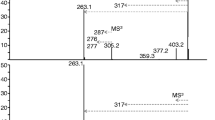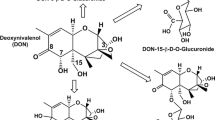Summary
Sensitive, reliable and convenient assays are described for the study of human liver microsomal UDP-glucuronyltransferase. Using14C-1-naphthol as substrate about 2 mg of a liver biopsy specimen and for14C-morphine about 20 mg of tissue will suffice for enzyme estimation. Lack of inhibition of 1-naphthol glucuronidation by morphine suggests that the substrates are glucuronidated by different forms of the enzyme. Enzyme levels in the native and activated state were studied in biopsies from patients grouped according to histopathological and clinical criteria. The enzyme assays may help to characterize UDP-glucuronyltransferases in human tissues and their induction by drugs and environmental chemicals, as well as their alteration in various diseases.
Similar content being viewed by others
Abbreviations
- GT:
-
UDP-glucuronyltransferase
- UDPNAG:
-
UDP-N-acetylglucosamine
- UDPGA:
-
UDP-glucuronic acid
References
Dutton, G. J.: Glucuronide-forming enzymes. Handb. exp. Pharm., 28 (2), pp. 378–400. Berlin, Heidelberg, New York: Springer 1971
Schmid, R.: Hyperbilirubinemia. In: The metabolic basis of inherited diseases. Stanbury, J. B., Wyngaarden, J. B., Fredrickson, D. S. (eds.) pp. 1141–1178. New York: McGraw-Hill 1972
Fevery, J., Van Damme, B., Michiels, R., De Groote, J., Heirwegh, K. P. M.: Bilirubin conjugates in bile of man and rat in the normal state and in liver disease. J. clin. Invest.51, 2482–2492 (1972)
Kunin, C. M., Glazko, A. J., Finland, M.: Persistence of antibiotics in blood of patients with acute renal failure. II. Chloramphenicol and its metabolic products in the blood of patients with severe renal disease or hepatic cirrhosis. J. clin. Invet.38, 1498–1508 (1959)
Yeh, S. Y.: Urinary excretion of morphine and its metabolites in morphine-dependent subjects. J. Pharmacol. exp. Ther.192, 201–210 (1975)
Vessmann, J., Alexanderson, B., Sjöquist, F., Strindberg, B., Sundwall, A.: Comparative pharmacokinetics of oxacepam and nortriptyline after single oral doses in man. In: The Benzodiazepines. Garattini, S., Mussini, E., Randall, L. O. (eds.) pp. 165–173. New York: Raven-Press 1973
Heni, N., Glogner, P.: Pharmacokinetics of phenprocoumon in man investigated using a gas chromatographic method of drug analysis. Naunyn-Schmiedeberg's Arch. Pharmacol.293, 183–186 (1976)
Weiss, C. F., Glazko, A. J., Weston, J. K.: Chloramphenicol in the newborn infant. A physiologic explanation of its toxicity when given in excessive doses. New Engl. J. Med.262, 787–794 (1960)
Trolle, D.: Decrease in total serum bilirubin concentration in newborn infants after phenobarbitone treatment. Lancet1968/II, 705–708
Black, M., Billing, B. H., Heirwegh, K. P. M.: Determination of bilirubin UDP-glucuronyltransferase activity in needlebiopsy specimens of human liver. Clin. Chim. Acta29, 27–35 (1970)
Dutton, G. J.: Control of UDP-glucuronyltransferase activity. Biochem. Pharmacol.24, 1835–1841 (1975)
Arias, I. M., Gartner, L. M., Cohen, M., Ezzer, J., Levi, A. J.: Chronic nonhemolytic unconjugated hyperbilirubinemia with glucuronyltransferase deficiency: Clinical, biochemical, pharmacologic and genetic evidence for heterogeneity. Am. J. Med.47, 395–409 (1969)
Black, M. and Billing, B. H.: Hepatic bilirubin UDP-glucuronyltransferase activity in liver disease and Gilbert's syndrome. New Engl. J. Med.280, 1266–1271 (1969)
Felsher, B. F., Carpio, N. M., Wooley, M. M., Asch, M. J.: Hepatic bilirubin glucuronidation in neonates with unconjugated hyperbilirubinemia and congenital gastroinstestinal obstruction. J. Lab. clin. Med.83, 90–96 (1974)
Felsher, B. F., Carpio, N. M.: Non-familial unconjugated hyperbilirubinemia and reduced bilirubin UDP-glucuronyl-transferase activity in patients with chronic persistent hepatitis. Gastroenterology73, A-22/1220 (1977)
Bock, K. W., White, I. N. H.: UDP-glucuronyltransferase in perfused rat liver and in microsomes: Influence of phenobarbital and 3-methylcholanthrene. Eur. J. Biochem.46, 451–459 (1974)
Del Villar, E., Sanchez, E., Autor, A. P., Tephly, T. R.: Morphine metabolism. III. Solubilisation and separation of morphine and p-nitrophenol uridine diphospho-glucuronyltransferases. Mol. Pharmacol.11, 236–240 (1975)
Lowry, O. H., Rosebrough, N. J., Farr, A. L., Randall, R. J.: Protein measurement with the folin phenol reagent. J. biol. Chem.193, 265–275 (1951)
Zakim, D., Vessey, D. A.: The effects of lipid-protein interactions on the kinetic parameters of microsomal UDP-glucuronyltransferase. In: The Enzymes of Biological Membranes, Vol. 2. A. Martonosi (ed.), pp. 443–461. New York: Plenum Press 1976
Schoene, B., Fleischmann, R. A., Remmer, H., Oldershausen, v. H. F.: Determination of drug metabolizing enzymes in needle biopsies of human liver. Europ. J. clin. Pharmacol.4, 65–73 (1972)
Black, M., Perrett, R. D., Carter, A. E.: Hepatic bilirubin UDP-glucuronyltransferase activity and cytochrom P-450 content in a surgical population and effects of preoperative drug therapy. J. Lab. clin. Med.81, 704–712 (1973)
Bock, K. W., Fröhling, W., Remmer, H., Rexer, B.: Effects of phenobarbital and 3-methylcholanthrene on substrate specificity of rat liver microsomal UDP-glucuronyltransferase. Biochem. Biophys. Acta327, 46–56 (1973)
Bock, K. W., Clausbruch, v. U. C., Josting, D., Ottenwälder, H.: Separation and partial purification of two differentially inducible UDP-glucuronyltransferases from rat liver. Biochem. Pharmacol.26, 1097–1100 (1977)
Del Villar, E., Sanchez, E., Tephly, T. R.: Isolation of separate glucuronyltransferase activities for morphine and p-nitrophenol from rabbit liver microsomes. Drug. metab. Disp.5, 273–278 (1977)
Bock, K. W., Kittel, J., Josting, D.: Purification of rat liver UDP-glucuronyltransferase: Separation of two enzyme forms with different substrate specifity and differential inducibility. In: Conjugation Reactions in Drug Biotransformation. Aitio, A. (ed.). Amsterdam: Elsevier/North-Holland 1978
Verity, M. A., Caper, R., Brown, W. J.: Spectrofluorometric determination of β-glucuronidase activity. Arch. Biochem. Biophys.106, 386–393 (1964)
Frei, J., Schmid, E., Birchmeier, H.: UDP-glucuronyltransferase. In: Methoden der enzymatischen Analyse, Vol. 2. Bergmeyer, H. U. (ed.), pp. 763–768. Weinheim: Verlag Chemie, 1974
Takeda, K.: Enzymatic studies of glucuronide formation in impaired liver. III. Effects of carbon tetrachloride and ectromelia virus infection on liver glucuronide formation in mouse. Acta Med. Okoyama16, 99–111 (1962)
Aitio, A.: Effect of chrysene and carbon tetrachloride administration on rat hepatic microsomal monooxygenase and UDP-glucuronyltransferase activity. FEBS Lett.42, 46–49 (1974)
Bock, K. W., Huber, E., Schlote, W.: UDP-glucuronyltransferase in perfused rat liver and in microsomes: Effects of CCl4 injury. Naunyn-Schmiedeberg's Arch. Pharmacol.296, 199–203 (1977)
Järvisalo, J., Savolainen, H., Vainio, H.: Effects of acute CS2 intoxication on liver protein and drug metabolism. Chem. Biol. Interactions17, 41–50 (1977)
Järvisalo, J., Kilpiö, J., Elovaara, E., Vainio, H.: Deleterious effects of subacute carbon disulfide exposure on mouse liver. Biochem. Pharmacol.26, 1521–1524 (1977)
Marselos, M., Lang, M., Törröen, R.: Modifications of drug metabolism by disulfiram and diethyldithiocarbamate II. D-glucuronic acid pathway. Chem. Biol. Interactions15, 277–287 (1976)
Josting, D., Winne, D., Bock, K. W.: Glucuronidation of paracetamol, morphine and 1-naphthol in the rat intestinal loop. Biochem. Pharmacol.25, 613–616 (1976)
Gorski, J. P., Kasper, C. B.: Purification and properties of microsomal UDP-glucuronyltransferase from rat liver. J. biol. Chem.252, 1336–1343 (1977)
Burchell, B.: Purification of UDP-glucuronyltransferase from untreated rat liver. FEBS Lett.78, 101–104 (1977)
Bock, K. W.: Konjugation von Bilirubin: Enzymatische Aspekte. Verh. Dtsch. Ges. inn. Med.82, 468–494 (1976)
Author information
Authors and Affiliations
Rights and permissions
About this article
Cite this article
Bock, K.W., Brunner, G., Hoensch, H. et al. Determination of microsomal UDP-glucuronyltransferase in needle-biopsy specimens of human liver. Eur J Clin Pharmacol 14, 367–373 (1978). https://doi.org/10.1007/BF00611908
Received:
Accepted:
Issue Date:
DOI: https://doi.org/10.1007/BF00611908




